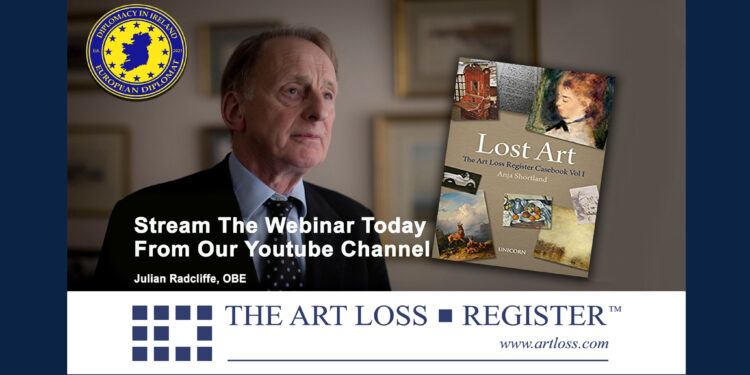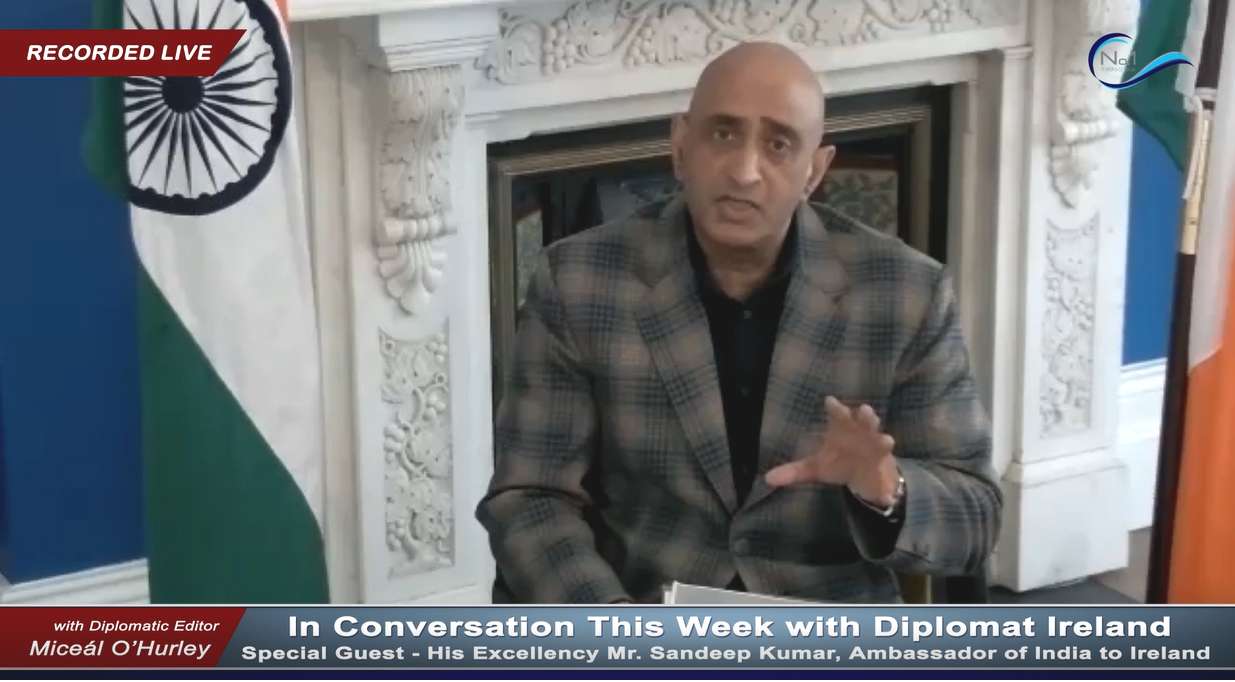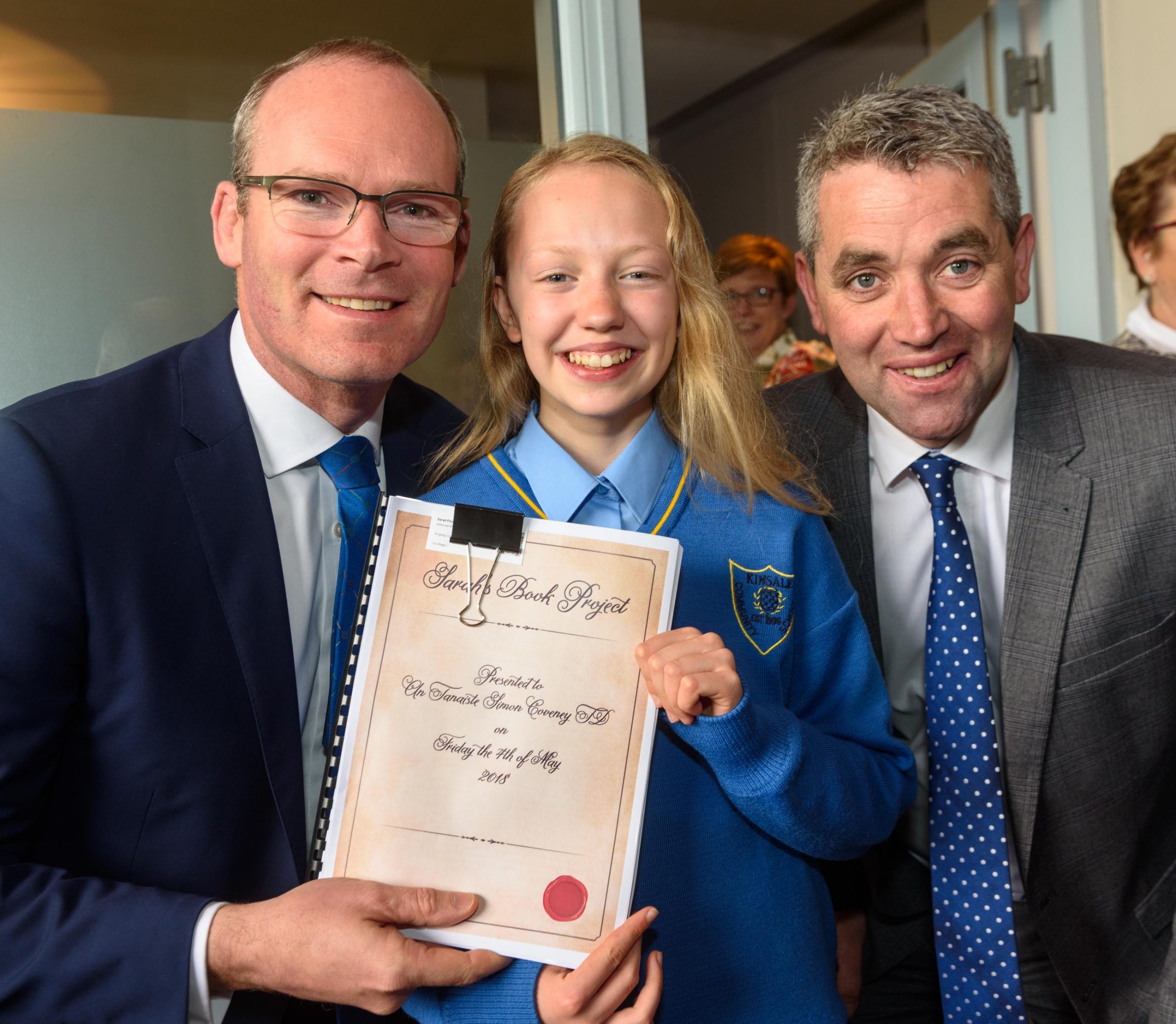by Miceál O’Hurley
DUBLIN – If you missed on 20 January 2022 expert Webinar entitled, Stolen, Looted & Disputed: Diplomatic and Legal Issues in Art with renown expert Julian Radcliffe, OBE of the Art Loss Register, you can now watch the entire webinar at your convenience on the Diplomacy in Ireland – European Diplomat YouTube Channel. The webinar was streamed as part of our ongoing interview series, ‘In Conversation This Week with Miceál O’Hurley‘.
The Webinar, an interview conducted by Editor-in-Chief Dr. Miceál O’Hurley, covered topics including:
- Looting of antiquities
- Thefts from museums
- Loss in conflict
- Illegal export
- Disputes on ownership/restitution
Resolutions - Database developments
- UNESCO strengths/limitations
- Policing the art market Law enforcement /Governance
- Diplomatic engagement in the recovery and return of stolen, looted and disputed art and cultural artefacts
It is anticipated that Julian Radcliffe will deliver an educational seminar for the the diplomatic corps (Ambassadors and Cultural Attaché), curators, administrators, auction houses, museums and Ambassadors in mid-March. If you would like to be added to this information list, please notify us at: editor@diplomacyireland.eu so we can notify you once the date and time are fixed.
Art Loss Register Casefiles Book (2021)
 Author Anja Shortland‘s collaboration with Julian Radcliffe, OBE resulted in the insightful, interesting and enjoyable book, Lost Art: The Art Loss Register Casebook Vol. 1.
Author Anja Shortland‘s collaboration with Julian Radcliffe, OBE resulted in the insightful, interesting and enjoyable book, Lost Art: The Art Loss Register Casebook Vol. 1.
Countless dollars of art are stolen or looted every year, yet governments often consider art theft a luxury problem. With limited public law enforcement, what prevents thieves, looters and organised criminal gangs from flooding the market with stolen art? How can theft victims get justice – even decades after their loss? What happens if the legal definition of a good title is at odds with what is morally right? Enter the Art Loss Register, a private database dedicated to tracking down stolen artworks. Blocking the sale of disputed artworks creates a space for private resolutions – often amicable and sometimes entertainingly adversarial. This book is based on ten cases from the Art Loss Register’s archive, showing how restitutions were negotiated, how priceless objects were retrieved from the economic underworld and how thieves and fences end up in court and behind bars. A fascinating guide to the dark side of the global art market.
Copies of Lost Art: The Art Loss Register Casebook Vol. 1. can be found at your local bookshop or on Amazon.
Background
In conventional criminal theft of cultural goods, the role of a database is very clear; to record the stolen objects and to provide a due diligence searching service to prevent their sale in the market and assist with recovery.
This service cannot be provided by Interpol or any one nations police run operations since Interpol’s database is limited to what national forces ask to be circulated which is a very small proportion of what is stolen and most police force databases are “closed,” i.e. they can only be searched by the police themselves since they contain information on the criminal investigation and the theft victims.
Furthermore the Interpol database is “open” to anyone to search with no follow up to a match so the keenest searchers are probably criminals who wish to know what is registered to work out how to sell it without detection and doubtful dealers who know that Interpol has a very restricted list and if some item is not on it they claim due diligence.
Hence the creation in 1990 of a private sector database which is internationally recognised as the authoritative minimum level of due diligence searching and which is “managed,” i.e. all registrations are carefully analysed to keep up the standards of the data, and all searches under contracts, are undertaken by members of staff.
This ensures the highest level of matching and full disclosure of the identity of the searcher so that all matches can be followed up and the searcher has to cooperate. This prevents criminals finding out easily what is on or not on the database to prevent them trying to outwit the searching.
This is of course a more expensive system to operate than an “open” database and the investment required and international marketing to reach critical mass defeated the not for profit (IFAR in NEW York) which had started the project. Hence the formation of a company with shareholders which included Sotheby’s and Christies, Insurers and venture capital. The Art Loss Register now has 50 staff, carries out over 450,000 paid searches for 140 auction houses, dealers, museums et al and at any one time is handling over 300 recoveries including stolen watches.
This is an example of a private public partnership which the police have to recognise that if they cannot provide the deterrence, and information and expertise required to counter crime that they must encourage the private sector to do.
Cultural items which are national patrimony and have been catalogued and are stolen from museums can be registered with the ALR with the added advantage that the law in many countries will recognise them as inalienable and so on discovery they may be returned without any compensation to a possessor who claims a good faith purchase.
Positive Pre-Loss Registration
Alongside the registration of objects reported as stolen or missing, the ALR has also launched the Cultural Heritage At Risk Database (CHARD) to register objects in situ at museums, warehouses and archaeological sites, to ensure that if such items are stolen (and not reported ) they can be identified if offered for sale. This service is offered to complement the hard work of the museum professionals and archaeologists who painstakingly record these objects in the first place, as well as those who risk their lives every day to protect them. The project hopes to assist in the protection of these objects in perpetuity by informing registrant governments, ministries, museums or archaeologists – as well as any relevant law enforcement agencies – should those objects appear on the market.
There is a limit to the volume of these items that can be registered without slowing down the searching speeds since every search gives rise to near matches which have to be excluded by human analysis. The ALR has taken part in educational seminars in Lebanon and elsewhere on these issues.
But there are many items considered patrimony which are not well catalogued and may still be in the ground or under water still to be excavated, and at risk from looting. What can be done by a database when those items cannot be entered on it? The answer is more than you or some dishonest dealers may suspect.
The Trade
The Art Loss Register concept is that ultimately all items sold should been checked against the database and that search is recorded with a full audit trail. This gives an independently verifiable record of the stock a dealer has and when he got it. If a dealer has not searched an item and normally does then this gives a flag of suspicion.
To undertake a search a dealer has to provide the provenance, ie from whom, when and how obtained (purchased, swopped, inherited, etc) and further questions may be asked about the earlier provenance with documentation requested. There are many legitimate antiquities in private hands which have no clear evidence of their provenance and which have been inherited and not considered of importance.
But without clear evidence of ownership at a date early enough to pre date any legislation in the exporting or indeed now importing country), on illegal excavation or export, the item may be unsaleable.
Clearly all of this depends on a high level of searching by the dealers and auction houses to change the norms of the antiquities world so that without a satisfactory provenance the item is of no value financially even if it may be of great academic or aesthetic interest.
In several cases dealers have made up provenance which the Art Loss Register has with the help of experts such as the British Museum been able to challenge and return the item to the relevant Government when the dealer has accepted that hand over is the only option. Some antiquities have been left in our lobby.
The Antiquity Dealers Associations have in the main accepted the inevitable, although with much argument about the cut off dates which have been more lenient than the UNESCO prescription.
We can claim that the ALR has made the sale of conventionally stolen items more difficult to sell as criminals have reported their interest in other types of crime as being now more profitable in relation to risk. Sadly this displacement was always more likely than honest endeavour as an outcome.
But any improvement in the antiquities world from the database operation has probable been masked by the continuing conflict /poverty and disruption from conflicts, the covid pandemic and natural disasters in the Middle East and elsewhere and the extent of the unethical and illegal buying in parallel with the ready supply.
Education of Collectors and Museums is reducing the secondary market in value and eventually volume forcing the dealers close to the source countries to reduce their prices and interest. So much for the current and recent looting. What about the past.
Historic Collections
Countries have become increasingly aware of their history, identity and culture, both for nationalistic reasons and as tourism has become one of the fastest growing and most lucrative sources of revenue for less well of countries.
The standards of today are now applied retroactively to the events of previous centuries calling into question the behaviour of the Romans, Napoleon, the British Empire and all colonialism. It seems likely that there will be a gradual reappraisal of what can be retained in Western museums, given their relative security and availability to educate about foreign cultures, and what is so unique to a country that it should be returned.
Some Possible Answers
But there are many compromises which must be explored eg the question of ownership need not be viewed as single and indivisible, it can be shared and more focused on the income to be derived from exhibition, and publication. The ALR is active in dispute resolution including Governments and is often a cheaper and more effective way than litigation, with moral arguments now being more important than the pure law.
The practice of a foreign University paying for archaeological exploration of a site and have an agreement to sell a proportion of the finds has fallen into disrepute as a relic of colonial times. But we need some more imaginative and practical answers which produce the funds to secure sites and explore some of them.
Perhaps the creation of a new market of authorised items which are too numerous to be retained or displayed in the source country would help defeat the illegal trade and provide some funding.
















































